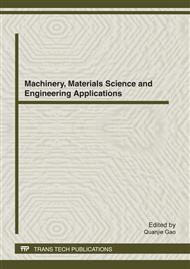[1]
O.P. Karasevskaya, O.M. Ivasishin, S.L. Semiatin and Y.V. Matviychuk: Materials Science and Engineering A Vol. 354 (2003), pp.121-132.
DOI: 10.1016/s0921-5093(02)00935-8
Google Scholar
[2]
V.V. Balasubrahmanyam and Y.V.R.K. Prasad: Materials Science and Engineering A Vol. 336 (2002), pp.150-158.
Google Scholar
[3]
N.G. Jones, R.J. Dashwood, D. Dye and M. Jackson: Materials Science and Engineering A Vol. 490 (2008), pp.369-377.
Google Scholar
[4]
I. Weiss and S.L. Semiatin: Materials Science and Engineering A Vol. 243 (1998), pp.46-65.
Google Scholar
[5]
M.F. Horstemeyer and D.J. Bammann: International Journal of Plasticity Vol. 26 (2010), pp.1310-1334.
Google Scholar
[6]
B. Esteban P: International Journal of Plasticity Vol. 14 (1998), pp.319-353.
Google Scholar
[7]
J. Lin, Y. Liu, D. Farrugia and M. Zhou: Philosophical Magazine Vol. 85 (2005), p.1967-(1987).
Google Scholar
[8]
J. Luo, M. Li, X. Li and Y. Shi: Mechanics of Materials Vol. 42 (2010), pp.157-165.
Google Scholar
[9]
X.G. Fan and H. Yang: International Journal of Plasticity Vol. 27 (2011), pp.1833-1852.
Google Scholar
[10]
N.G. Jones, R.J. Dashwood, D. Dye and M. Jackson: Metallurgical and Materials Transactions A Vol. 40A (2009).
Google Scholar
[11]
H. Mecking, U.F. Kocks and C. Hartig: Scripta Materialia Vol. 35 (1996), pp.465-471.
DOI: 10.1016/1359-6462(96)00137-6
Google Scholar
[12]
R. Stoller and S. Zinkle: Journal of Nuclear Materials Vol. 283 (2000), pp.349-352.
Google Scholar
[13]
E. Nes, T. Pettersen and K. Marthinsen: Scripta Materialia Vol 43 (2000), pp.55-62.
DOI: 10.1016/s1359-6462(00)00363-8
Google Scholar
[14]
S. Nemat-Nasser, W.G. Guo and D.P. Kihl: Journal of the Mechanics and Physics of Solids Vol. 49 (2001), pp.1823-1846.
Google Scholar
[15]
I.J. Beyerlein and C.N. Tomé: International Journal of Plasticity Vol. 24 (2008), pp.867-895.
Google Scholar
[16]
S. Semiatin, F. Montheillet, G. Shen and J. Jonas: Metallurgical And Materials Transactions A Vol. 33 (2002), pp.2719-2727.
Google Scholar
[17]
P. Vo, M. Jahazi, S. Yue and P. Bocher: Materials Science and Engineering A Vol. 447 (2007), pp.99-110.
Google Scholar
[18]
Y. Varshni: Physical Review B Vol. 2 (1970), p.3952.
Google Scholar
[19]
U.F. Kocks and H. Mecking: Progress in Materials Science Vol. 48 (2003), pp.171-273.
Google Scholar
[20]
Y. Estrin, L. Toth, A. Molinari and Y. Brechet: Acta Materialia Vol. 46 (1998), pp.5509-5522.
Google Scholar
[21]
S.L. Semiatin and T.R. Bieler: Acta Materialia Vol. 49 (2001), pp.3565-3573.
Google Scholar
[22]
J. Lin and J. Yang: International Journal of Plasticity Vol. 15 (1999), pp.1181-1196.
Google Scholar


